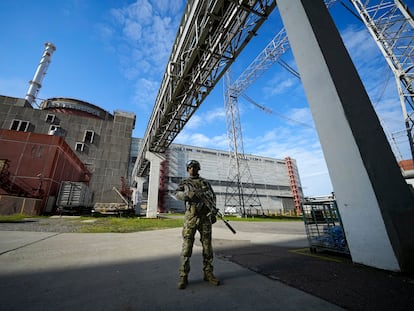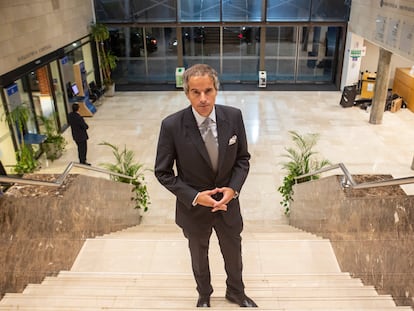UN nuclear watchdog’s concerns grow over Ukraine Zaporizhzhia plant safety
Rafael Grossi’s comments came after the governor of the Russia-occupied area ordered the evacuation of a town where most plant staff live amid ongoing attacks in the area

The head of the United Nations’ nuclear watchdog is expressing growing anxiety about the safety of the Zaporizhzhia Nuclear Power Plant, after the governor of the Russia-occupied area ordered the evacuation of a town where most plant staff live amid ongoing attacks in the area.
The plant is near the front lines of fighting, and Ukrainian authorities on Sunday said that a 72-year-old woman was killed and three others were wounded when Russian forces fired more than 30 shells at Nikopol, a Ukrainian-held town neighboring the plant.
“The general situation in the area near the Zaporizhzhya Nuclear Power Plant is becoming increasingly unpredictable and potentially dangerous,” International Atomic Energy Agency head Rafael Grossi said in a warning that came Saturday before the latest report of attacks.
“I’m extremely concerned about the very real nuclear safety and security risks facing the plant.”
Grossi’s comments were prompted by an announcement Friday by Yevgeny Balitsky, the Russian-installed governor of the partially-occupied Zaporizhzhia province, that he had ordered the evacuation of civilians from 18 settlements in the area, including Enerhodar, which is located next to the power plant, which is Europe’s largest.
The settlements affected are about 50 to 70 kilometers (30 to 40 miles) from the front line of fighting between Ukraine and Russia, and Balitsky said that Ukraine had intensified attacks on the area in the past several days.
Analysts have for months pointed to the southern Zaporizhzhia region as one of the possible targets of Ukraine’s expected spring counteroffensive, speculating that Kyiv’s forces might try to choke off Russia’s “land corridor” to the Crimean Peninsula and split Russian forces in two by pressing on to the Azov Sea coast.
In a Telegram post on Sunday, the exiled Ukrainian mayor of the Russia-occupied coastal city of Mariupol said that there was evidence that Moscow’s forces had intensified their transfer of tracked vehicles through the city and into the front-line Zaporizhzhia region.
Petro Andryushchenko claimed that more and more vehicles were being spotted crossing the city “every day.”
He posted a short video showing heavy trucks transporting armored vehicles along an expressway, without specifying where or when it was taken.
In Enerhodar, the Ukrainian General Staff said Sunday that the evacuation announced Friday had already begun.
According to an update posted on Facebook, the General Staff said the first residents evacuated were those who took Russian citizenship following the capture of the town by Moscow early in the war.
They were being taken to the Russia-occupied Azov Sea coast, about 200 kilometers (120 miles) to the southeast.
Grossi said that operating staff of the nuclear power plant, whose six reactors are currently all in shutdown mode, hadn’t been evacuated as of Saturday but that most live in Enerhodar and the situation has contributed to “increasingly tense, stressful and challenging conditions for personnel and their families.”
He added that IAEA experts at the nuclear site “are continuing to hear shelling on a regular basis.”
“We must act now to prevent the threat of a severe nuclear accident and its associated consequence for the population and the environment,” Grossi said. “This major nuclear facility must be protected. I will continue to press for a commitment by all sides to achieve this vital objective.”
Elsewhere, Russian shelling on Saturday and overnight killed six civilians and wounded four others in Ukraine’s southern Kherson region, according to a Telegram update published Sunday by the local administration.
Five civilians were wounded in the eastern Donetsk region, the epicenter of the fighting in recent months, local Gov. Pavlo Kyrylenko reported on Sunday morning.
Meanwhile, Ukrainian forces overnight attacked the largest port in Russia-occupied Crimea with drones, a Kremlin-installed local official said on Telegram early Sunday.
According to the post by Mikhail Razvozhayev, the governor of Sevastopol, 10 Ukrainian drones targeted the city, three of which were shot down by air defense systems. Razvozhayev said that there had been no damage.
Sign up for our weekly newsletter to get more English-language news coverage from EL PAÍS USA Edition
Tu suscripción se está usando en otro dispositivo
¿Quieres añadir otro usuario a tu suscripción?
Si continúas leyendo en este dispositivo, no se podrá leer en el otro.
FlechaTu suscripción se está usando en otro dispositivo y solo puedes acceder a EL PAÍS desde un dispositivo a la vez.
Si quieres compartir tu cuenta, cambia tu suscripción a la modalidad Premium, así podrás añadir otro usuario. Cada uno accederá con su propia cuenta de email, lo que os permitirá personalizar vuestra experiencia en EL PAÍS.
¿Tienes una suscripción de empresa? Accede aquí para contratar más cuentas.
En el caso de no saber quién está usando tu cuenta, te recomendamos cambiar tu contraseña aquí.
Si decides continuar compartiendo tu cuenta, este mensaje se mostrará en tu dispositivo y en el de la otra persona que está usando tu cuenta de forma indefinida, afectando a tu experiencia de lectura. Puedes consultar aquí los términos y condiciones de la suscripción digital.
More information
Archived In
Últimas noticias
Maduro pleads not guilty before the federal court in New York: ‘I am still the president of Venezuela’
A new test can detect Alzheimer’s from a finger prick
UN team enters Sudanese city of El Fasher after paramilitary massacre: ‘It’s like a ghost town’
A recipe for resistance: Indigenous peoples politicize their struggles from the kitchen
Most viewed
- Gilles Lipovetsky: ‘If you want to live better and fall in love, take Prozac, don’t look to philosophy’
- Alain Aspect, Nobel laureate in physics: ‘Einstein was so smart that he would have had to recognize quantum entanglement’
- Alvin Hellerstein, a 92-year-old judge appointed by Bill Clinton, to preside over Maduro’s trial in New York
- Why oil has been at the center of Venezuela-US conflicts for decades
- Maduro’s downfall puts China’s relationship with Venezuela to the test










































